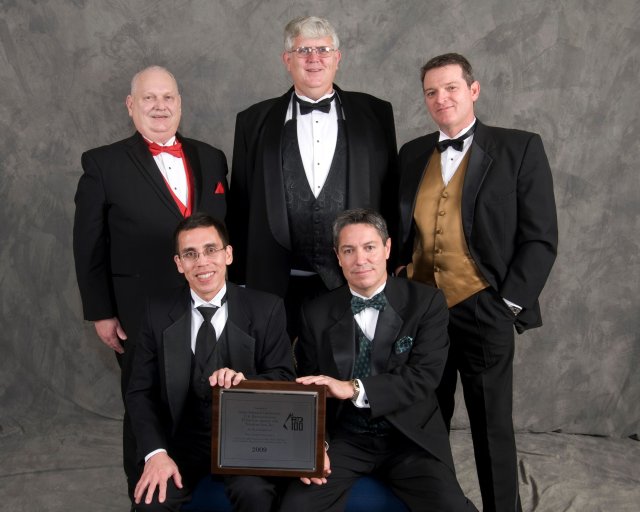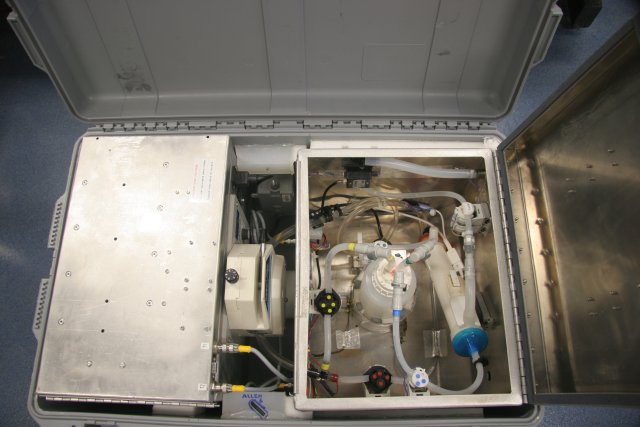Portable Device to Concentrate Water Samples for Microorganism Analysis
Owned by EPA
Link to Video on Water Concentrator Technology
Federal Technology Transfer Act (FTTA) staff: Contact us if you are interested in learning more about how to license this technology.
Summary of the Technology

Handling of large volumes of potentially contaminated water is a safety concern for the transporters, laboratory personnel, and public. EPA teamed with the DOE’s Idaho National Laboratory (INL) to develop a rugged and automated field deployable sample concentration device. The device reduces the sample volume by concentrating microorganisms contained in a large sample into a small volume of water. This can concentrate microbes in a 26-gallon sample into less than 2 cups of water, in less than an hour. Following concentration, the smaller, concentrated sample can be more easily and safely transported to a laboratory.
For the development of this filtration device, EPA and INL researchers received a 2009 R&D 100 Award from R&D Magazine. Each year, editors of R&D Magazine bestow the prestigious R&D 100 Award to help new products compete in the marketplace. From R&D Magazine, “winning of an R&D 100 Award provides a mark of excellence known to industry, government, and academia”.
Background
The possibility of terrorists or criminals intentionally contaminating drinking water with pathogenic microorganisms is a significant public health concern. This concern gave rise to the need to effectively sample water to detect small concentrations of potentially dangerous microorganisms. Detection of low concentrations of microorganisms in water necessitates for a large volume water sample (i.e., 26 gallons). The larger the sample, the greater likelihood of capturing microorganisms present at low levels. The conventional practice has been to transport the large volume sample to a laboratory for concentration and analysis. This is cumbersome for personnel, and transporting large volumes of samples that may contain a biological hazard can be expensive.
How the Technology is Different
Using a computer controlled system, this ultrafiltration device automates the process of concentrating a water sample and is field-mobile. This system reduces human exposure to potentially contaminated water and generates samples appropriate for analyses of several types of microorganisms. The underlying technology has been tested by several laboratories.
The ultrafiltration device:
- Reduces sample collection and concentration time and cost – Sample concentration processes are automated, which reduces the time it takes to determine pathogen concentration. Because only a concentrated sample is shipped to a laboratory, the cost of transport is less. A one hundred liter water sample can often be processed and concentrated in about an hour.
- Improves accuracy and consistency – By using a large sample volume, analytical sensitivities improved by as much as 250 percent over smaller volume assays. Concentrated samples help ensure that low concentrations of microorganisms are accurately identified. The automation of processes that were previously performed manually in the laboratory should help improve the consistency of sample preparation.
- Requires minimal setup and training
- Allows for real-time monitoring – The computer provides a virtual display of filtration, allowing operators to monitor statuses and respond to operational issues during sampling.
- Eliminates cross-contamination – All device parts that come in contact with the sample water (e.g., tubing, fittings, pressure transducer) are single use items. This ensures that there is no cross-contamination between samples. The device includes quick disconnects for sample removal.
- Increased safety – Handling of small water samples means less likelihood for spillage, which decreases risk to transporters, personnel and general public.

The dimensions of the ultrafiltration device are 31 x 20 x 16 inches, meaning it fits into a car trunk. It consists of a pump, valves, sensors, electronic controls, a hollow fiber filter cartridge and a sample bottle. The device is controlled by software that can be installed on a personal computer. The device pumps water through a filter, while maintaining 10 to 25 pounds per square inch pressure within the filter. This pressure difference forces the water to be discarded through a hollow fiber filter, while microorganisms remain in the sample.
Additional Uses
The ultrafiltration device could be used by water utilities during their routine regulatory compliance sampling. This routine sampling includes testing for several different microorganisms in drinking water. The ultrafiltration device may also be useful for sampling:
- Bilge water on shipping vessels
- Process control liquids from the brewing and pharmaceutical industries
- Surface water for environmental studies
- Decontamination water from cleanup areas.
The ultrafiltration device might be useful in concentrating samples for targeted pathogens specified in EPA's new water reuse guidelines. These pathogens could include large molecular weight toxins like ricin, yeasts, fungi, viruses, protozoa and helminths.
